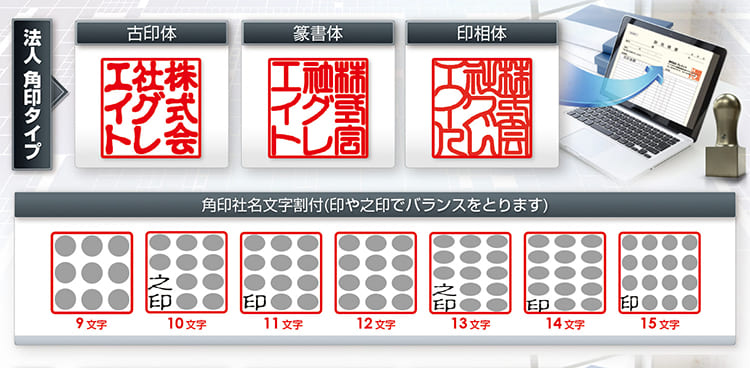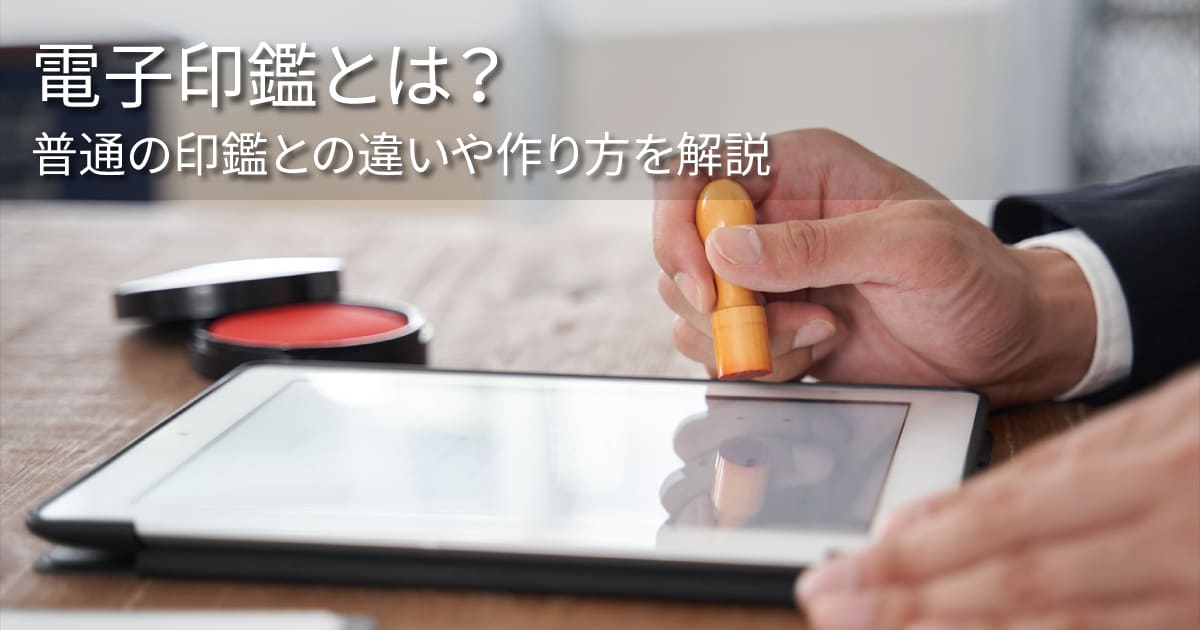Electronic HANKO are extremely efficient and convenient when it is necessary to exchange HANKO in business situations. Some companies stamp documents on paper, while others have already introduced electronic HANKO. What is the difference between an electronic HANKO and a regular HANKO? We will also explain the legal effect of electronic HANKO.
- What is an electronic HANKO?
- Background to the spread of electronic HANKO
- Types of HANKO used by individuals and corporations
- How to create an electronic HANKO
- Advantages of electronic HANKO
- Disadvantages of electronic HANKO
- Stamp Hanko Shop 21 electronic HANKO
- Recommended fonts for electronic HANKO
- summary
What is an electronic HANKO?
What is an electronic HANKO ? An electronic HANKO (electronic seal) is an image of the HANKO imprint design pasted onto data in Excel or Word that can be viewed on a computer or other device.
To HANKO a regular seal, you need to print out a paper and then stamp it, but electronic HANKO are very convenient because they can be stamped just by operating a computer or other device without having to print them out. There is no need to worry about damage or deterioration such as loss or cracking of the HANKO.
Background to the spread of electronic HANKO
Electronic HANKO have become commonplace over the past few years, especially since the coronavirus pandemic. We will introduce the background of why electronic HANKO have become popular.
Promoting work style reform and changing times due to the coronavirus pandemic
Telework and the introduction of flextime systems have become widespread as part of work style reform, and the number of people working from home has rapidly increased due to the coronavirus pandemic.
"Coming to work with a stamp", which requires people to go to work to affix a stamp, has become a hot topic, but there are some tasks that can be resolved by introducing electronic HANKO, so even companies that have not previously adopted electronic HANKO are now using them. This was a great opportunity for us to actively adopt electronic HANKO.
Popularization of computers and tablets
It is not uncommon for a person to own multiple devices, including company computers, tablets and smartphones provided, and personal devices. It is suitable for the modern work style that allows work to be completed without the use of paper, and it can be said that the environment is conducive to the introduction of electronic HANKO.
Promoting digitalization of administrative services
The Digital Agency was established and the country is promoting digitalization. Some administrative procedures are moving to computerization, and things are changing little by little. As the digitization of administrative procedures progresses, companies that have not adopted it will be able to do so in the future, so it can be assumed that the number of companies that will introduce electronic HANKO will increase even more.
Types of HANKO used by individuals and corporations
HANKO are classified into those used by individuals, those used by corporations, and the purposes for which they are used. Let's take a closer look at the types of HANKO for individuals and corporations.
<Types of HANKO used by individuals>
registered seal
A registered seal is a HANKO that has been registered with the local government that has jurisdiction over your place of residence. If you register, you will be issued a HANKO registration card, and if you move or the local government that has jurisdiction over your place of residence changes, you will have to register HANKO again. A registered seal is an important HANKO that only one person can own. This is a HANKO used for buying and selling land or residences, and stamping important contracts.
bank seal
A HANKO that is submitted to a financial institution. There is no need to change the HANKO depending on the financial institution. Even if you have multiple bank accounts, you can use the same bank seal. Also, if you are using a savings passbook for your child, you can keep the bank stamp separate and give the passbook and bank stamp to your child in the future. You can decide freely depending on the purpose of use.
Seal
This is a HANKO that can be used without being registered, like a registered seal or a bank seal. This is the HANKO that is most often stamped in daily life.
Unlike a registered seal, it is possible to own multiple seals, one for work use, one for home use, etc. It is used in a variety of situations, such as processing documents at government offices, documents within the company, and receiving packages.
<Types of HANKO used by corporations>
Position seal (circle seal)
Among the official seals, the representative seal is the official seal of the company. The seal contains the company name and the title of the representative, and the HANKO is submitted to the Legal Affairs Bureau at the same time as the company is registered. A representative seal has legal effect, and like a registered seal, it is necessary when concluding important contracts. When creating an electronic HANKO, we recommend that you consider the risk of the image being leaked and use an electronic HANKO with a different impression from the actual representative seal.
Because the stamp surface is round, it is also called a round stamp.
company bank seal
This is a HANKO that is submitted and registered at the same financial institution as your personal bank seal when opening a company account. It is common to put "bank seal" in the middle letters of the seal to distinguish it from the representative's seal (the middle letters are the representative director's seal). This is also round, just like the representative seal, so it is generally made one size smaller to avoid confusing it with the representative seal.
Square seal (company seal)
A company seal is used like a personal seal for individuals. This is a HANKO that is often affixed to documents issued by companies, such as invoices and estimates. It is called a square seal because the face of the seal is square.
Since electronic HANKO are mainly used as identification seals, the square seal is the most commonly used form of electronic HANKO.
How to create an electronic HANKO
There are two ways to create an electronic HANKO: you can create it yourself, and you can create it using an electronic HANKO creation tool. Here we will introduce four methods.
Create your own using Office software or Paint software
The easiest way is to use Office software such as Word or Excel or paint software to design the face of a HANKO using shape tools and text, and then convert it into an image. The advantage is that anyone can easily create it, but it cannot be said that the design is high, and many people feel that it is lacking.
How to image the impression of a HANKO
This is a method of stamping the HANKO you are using on paper and scanning the seal impression. You can create electronic HANKO with more realistic fonts and ink ink colors than with Office tools. We do not recommend scanning a registered seal or bank HANKO to create an image as an electronic HANKO, as there is a risk that the image may be leaked.
Create an electronic HANKO creation service
There are also services such as Hanko Shop 21 that allow you to create electronic HANKO and have the seal image file delivered to you. Just like ordering a HANKO to be engraved, all you have to do is choose the shape and tell them the details of the HANKO and they will create it for you.
Advantages of electronic HANKO
Introducing the benefits of using electronic HANKO.
Make telework more comfortable with electronic HANKO
Telework has rapidly increased due to the coronavirus pandemic, but many companies have had trouble HANKO, such as not being able to receive approval stamps from their superiors unless they come to the office, and not being able to carry out normal operations without stamping. Introducing electronic HANKO will eliminate the need to come to work to affix stamps, and will help employees to freely choose how and where they work. By digitizing the stamping process, place and time constraints are eliminated.
Helps cut costs such as printing and postage costs
When HANKO an actual document, there are multiple steps and costs involved, such as printing out the document, stamping it, enclosing or mailing it if necessary, scanning the stamped document, and storing it as a PDF file. Masu. With electronic HANKO, all you have to do is stamp the document file you received via email and send the file back, which eliminates the hassle and cost of printing out and mailing, which can significantly reduce your time and costs in the long run. There may be cases.
Promoting paperless society
In addition to the printing and mailing costs, there is also the cost of the copy paper itself. There is also a place to store copy paper and other miscellaneous tasks such as ordering, delivery, and payment. By promoting a paperless environment, all processes related to document exchange can be made more efficient.
Reduced document storage space
Printing out and stamping documents requires managing and storing them. Even if it's just a few pieces a day, it will increase by box over the course of a year. Therefore, companies must also secure a place to store their documents, and many companies are worried about how to file them and where to store them. Stored documents need to be disposed of at the right time and in the right way, and you can see that the processes and costs associated with paper documents are surprisingly large.
Disadvantages of electronic HANKO
Although there are various advantages to using an electronic HANKO, there are also disadvantages.
Possibility of fraud damage
Since seal images are often pasted onto Office software or PDFs, there are cases where seal impressions are leaked or repurposed. With electronic HANKO, it is not possible to directly see the seal being affixed by the person in question, so there is a possibility of fraud. Use electronic contract services that are safe in terms of security and take measures to prevent unauthorized use.
There are cases where it is not possible to migrate to electronic HANKO.
Although the number of companies that are introducing electronic HANKO is increasing, the majority of companies still rely on paper-based communication. Therefore, if consent cannot be obtained from the other party without exchanging original documents, traditional paper exchanges will be required to conclude a contract.
Stamp Hanko Shop 21 electronic HANKO
Safe and secure original electronic HANKO
We design an original seal impression for each electronic HANKO. Since no existing fonts are used, you can create your own original electronic HANKO with confidence.
Clear impression and usability even in digital format
If you created an electronic HANKO using Office software or Paint, if you place an image of the electronic HANKO over text, the image or text underneath may be hidden by a white square.
Hanko Shop 21's electronic HANKO allow the seal impression to be transparent, so the images and text underneath are not obscured, allowing for a natural stamp that looks just like a real HANKO.
How to receive electronic HANKO data
Electronic HANKO are important data because they must be treated in the same way as HANKO.
At Hanko Shop 21, we deliver products to a special USB memory with a password, so you can rest assured about security.
Recommended fonts for electronic HANKO
Physical HANKO and electronic HANKO are different in format, but they are used for the same purposes and in the same situations. Therefore, it is recommended that the size and font of the seal be the same as a regular HANKO. Many of the HANKO used within the company are ceremonial seals, square seals, and round seals, so we will introduce three recommended fonts for these.
Seal (for personal use)
We recommend using a font that is easy to read for anyone to recognize at a glance. For this reason, we recommend using the basic calligraphy script called kaisho tai (kaisho tai) or the gyosho font (gyosho sho), which is a slightly different version of the cursive font. In addition, Kointai is a typeface that is based on Reisho, but has added roundness to it. Since it is unique to Japan, it has a unique atmosphere.

Square seal (corporate seal)
Recommended fonts for square seals, which can be considered corporate seals, are koin-tai, seal font, and inso-tai. The old seal is as introduced in the seal.
Seal calligraphy is characterized by the thickness of each stroke being uniform and vertical and horizontal lines. It has both geometric beauty and ancient grandeur.
Insō font is a typeface based on seal calligraphy, with the lines of the characters connected on the four sides of the periphery, giving it the appearance of little white space. It has the advantage of being difficult to copy, as the characters are difficult to decipher even if you look closely at the seal typeface.
Square stamps look better when the number of characters on each line is the same, so to match the number of characters, add "in" or "noin" after the company name to adjust the number of characters.

Circle seal (official seal)
Similar to the recommended fonts for square stamps, round stamps also use koin fonts, seal fonts, inso fonts, etc. Seal fonts and inso fonts that are difficult to decipher are chosen. The face of the round seal is a double circle, with the company name written in the outer circle (palindrome) and the title of the representative, etc. in the inner circle (medium letters).

summary
Above, we have explained the differences between electronic HANKO and regular HANKO, as well as their legal effects. While electronic HANKO are convenient, there are some points you should be aware of. There is also the possibility that the other party's consent cannot be obtained and it cannot be used. It is necessary to use electronic HANKO and regular HANKO depending on the usage situation, so be sure to understand the precautions.
 日本語
日本語 English
English 简体中文
简体中文 繁體中文
繁體中文 한국어
한국어 ไทย
ไทย Tiếng Việt
Tiếng Việt Indonesia
Indonesia Français
Français Español
Español Português
Português




